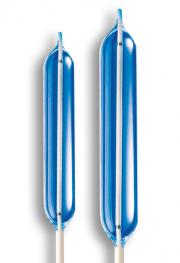INDICATIONS:
Recommended for Percutaneous Transluminal Valvuloplasty (PTV) of the pulmonary valve. • A patient with isolated pulmonary stenosis. • A patient with valvular pulmonary stenosis with other minor congenital heart disease that does not require surgical intervention.
CONTRAINDICATIONS:
Other than standard risks associated with insertion of a cardiovascular catheter, there are no known contraindications for valvuloplasty. The patient's medical condition could affect successful use of this catheter.
• Patients with mild valvular stenosis.
• A patient with valvular stenosis with major congenital heart defects that requires open heart surgery.
WARNINGS:
• CAUTION: Do not exceed the RBP. An inflation device with pressure gauge is recommended to monitor pressure. Pressure in excess of the RBP can cause balloon rupture and potential inability to withdraw the catheter through the introducer sheath.
• Catheter balloon inflation diameter must be carefully considered in selecting a particular size for any patient. The inflated balloon diameter should not be significantly greater than valvular diameter. The choice of the balloon size to be used for valve stenosis has been established by the VACA Registry to be approximately 1.2 to 1.4 times the valve annulus. It is important to perform an angiogram prior to valvuloplasty to measure the size of the valve in the lateral projection.
• Balloons ≥ 4cm in length may impinge upon the tricuspid valve mechanism and may injure it. Balloons longer than 4cm are not recommended for children ≤10 years old.
• Use only appropriate balloon inflation medium. Do not use air or gaseous medium to inflate the balloon.
• This catheter is not recommended for pressure measurement or fluid injection.
• Do not remove the guidewire from the catheter at any time during the procedure.
• This device is intended for single use only. Do not resterilize and/or reuse it, as this can potentially result in compromised device performance and increased risk of cross contamination.
• The catheter should be used prior to the 'Use Before' date noted on the package label.
• Right ventricular outflow tract damage has occurred with balloons larger than 1.5 times the size of valve annulus.
• THE CATHETER IS NOT INTENDED FOR USE WITH STENTS.
PRECAUTIONS:
• Dilatation procedures should be conducted under fluoroscopic guidance with appropriate x-ray equipment.
• Guidewires are delicate instruments. Care should be exercised while handling to help prevent the possibility of breakage.
• Careful attention must be paid to the maintenance of tight catheter connections and aspiration before proceeding to avoid air introduction into the system.
• Under no circumstances should any portion of the catheter system be advanced against resistance. The cause of the resistance should be identified with fluoroscopy and action taken to remedy the problem.
• If resistance is felt upon removal, then the balloon, guidewire, and the sheath should be removed together as a unit, particularly if balloon rupture or leakage is known or suspected. This may be accomplished by firmly grasping the balloon catheter and sheath as a unit and withdrawing both together, using a gentle twisting motion combined with traction.
• Before removing catheter from sheath it is very important that the balloon is completely deflated.
• Proper functioning of the catheter depends on its integrity. Care should be used when handling the catheter. Damage may result from kinking, stretching, or forceful wiping of the catheter.
